![]()
![]()
![]()
Use LEFT and RIGHT arrow keys to navigate between flashcards;
Use UP and DOWN arrow keys to flip the card;
H to show hint;
A reads text to speech;
26 Cards in this Set
- Front
- Back
|
What is prevalence?
|
Total number of cases of an illness out of those who are at risk for illness/condition
=(total number of cases at a given time)/total population at risk) |
|
|
What is incidence?
|
Number of NEW cases out of those at risk for condition
=(total number of NEW cases over given time)/(total population at risk) |
|
|
Prevalence vs Incidence:
Acute vs Chronic Diseases |
If acute, prevalence ~incidence (ex: H1N1)
If chronic, prevalence > incidence (ex: DM) |
|
|
What is relative risk?
|
Measures the risk of the outcome in the exposed group (ex: those who receive antibx) vs the risk of the outcome in the unexposed group
=Risk in exposed group/Risk in unexposed group |
|
|
When can relative risk be used?
|
Use in studies where you select participants by exposure:
Randomized Control Prospective/Retrospective Cohorts Cross-Sectional (can't do case control) |
|
|
What does a relative risk of 1 mean?
|
Same risk if you have exposure vs not have exposure
|
|
|
What is attributable risk?
|
The difference of risk between exposed and unexposed group
Shows the illness/condition cases that are attributable to that exposure |
|
|
What does an attributable risk of -.0013 mean?
|
A reduction 13 out of 10,000 cases can be attributed to a certain exposure
|
|
|
W hen can attributable risk be used?
|
randomized control
Prospective/Retrospective Cohorts Need to know how many people at risk at the beginning (just like in relative risk) |
|
|
What is number needed to treat?
|
Shows number of people who need to be treated in order for one person to benefit from the exposure/treatment
Higher NNT = less effective exposure/tx Lower NNT = more effective exposure/tx =inverse of attributable risk |
|
|
What does an number needed to treat of 769 mean?
|
Have to treat 769 patients to prevent one case of infection being studied
|
|
|
What is odds ratio?
|
Estimation for relative risk, when you can't calculate relative risk (often for case control studies--when you don't know the exposure, when you're working with the outcome)
=odds that case was exposed/odds control was exposed |
|
|
What does an odds ratio of 0.2 mean?
|
Ex with bacterial infections:
Children that had a bacterial infection had 0.2 times (or 1/5 times) the odds of having taken antibx. |
|
|
What does an odds ratio of 1 mean?
|
Odds of having exposure = Odds of not having exposure
|
|
|
Sensitivity vs Specificity:
Definitions Equation |
Sensitivity: Likelihood that those with the dz/condition will test positive for the dz/condition
Specificity: Likelihood that those without the dz/condition will test negative for the dz/condition SNOUT and SPIN: SeNsitivity rules it OUT SPecificity rules it IN Equations: Sensitivity = True Positives/(TP + FN) Specificity = TN/(TN + FP) |
|
|
You have one test that is sensitive but not specific for appendicitis. You have another test that is specific but not sensitive for appendicitis. How could you combine these tests to help you diagnose appendicitis?
|
Use highly sensitive tests for screening:
Don’t want to miss anyone Want all “true positives” to test positive Use highly specific tests for confirming : Don’t want to misclassify anyone Want all “true negatives” to test negative Between the two tests, should have an accurate representation of who has / doesn’t have the disease |
|
|
What are positive and negative predictive values and how do they differ from sensitivity/specificity?
|
Positive Predictive value measures the likelihood that those with a positive test will actually have the dz
Negative Predictive Value: likelihood that those with a negative test will not have the dz Unlike sensitivity/specificity, predictive values are not fixed measures (of the test), they are dependent on the prevalence of dz in the population of interest. |
|
|
What does a positive predictive value of 0.0009 mean?
|
If you have a positive test, the likelihood you will have the disease is 0.9%
|
|
|
What does a negative predictive value of 0.99 mean?
|
If you have a negative test, the likelihood you don't have appendicitis is 99%
|
|
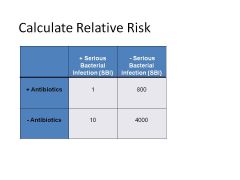
|

|
|
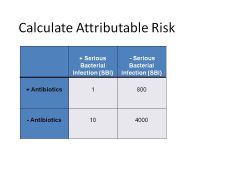
|

|
|

|
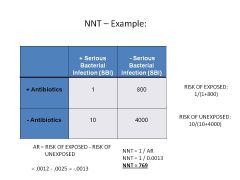
|
|

|
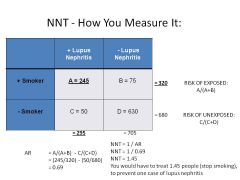
|
|

|
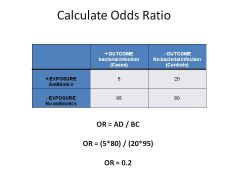
|
|
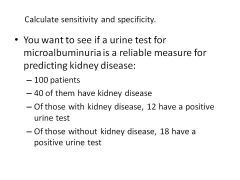
|

|
|
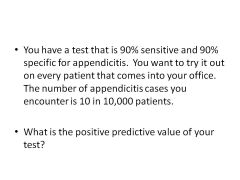
|

|

